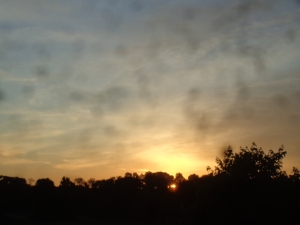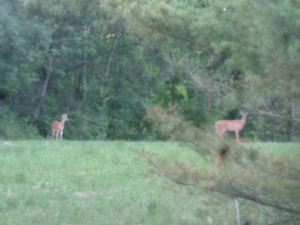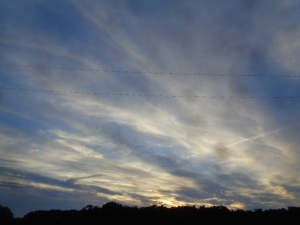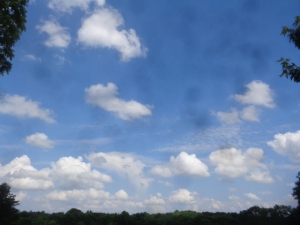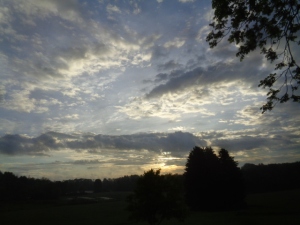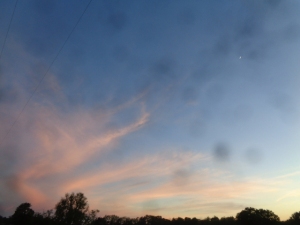
Summer Wonder Lisa A. Wisniewski
Summer has brought with it clearer, drier skies; a variety of blooming flowers, trees, and shrubs; and many aspects of life and nature to ponder. As we went about our activities this week, we found ourselves asking many questions about what we saw, heard, and felt. We marveled at how our senses can be so in tune to certain things, but oblivious to others at times. We also got to do some research on some plants and processes in nature to learn more about what we are seeing in the landscape. In all, it has been a productive week on a number of fronts, one of much learning and wondering, full of activities to engage the mind, body, and soul (which is how we like life to be in our household).

More to be Learned Lisa A. Wisniewski
“There is frequently more to be learned from the unexpected questions of a child than the discourses of men.” -John Locke
Wondering About Wonder
While riding my bike the other night, I found myself asking a number of questions about what I saw around me:
- What is that flower called? I’ll have to look it up in my book when I get home.
- The patterns in the clouds tonight are so pretty. I wonder is there a name for that pattern?
- What bird is that calling in the distance? Its song sounds familiar.
- I know there is a difference between poison hemlock and Queen Anne’s lace, but what is it?
- How can a bird like a pileated woodpecker create such a mess out of all the stumps in the area? Why are these birds doing this? Don’t they get a headache from all that tapping with their beaks?
- All this wondering has me wondering about the origin of the word wonder. Where did it come from? How many meanings does it have? When did I first learn this word?

Cloud Patterns Lisa A. Wisniewski
The list of questions grew as I pedaled through the miles. The one that kept nagging me most was the one about wonder. I was stuck on this two-syllable, six-letter word. Combing through the dictionary later, I discovered wonder is derived from the Old English wundor and akin to Old High German wuntar. Wonder can be a noun, a verb, or an adjective. As a noun, it can be defined in general as a cause of astonishment or adoration, a reason to marvel, or a feeling of doubt or uncertainty. As a verb, wonder can be summarized as to feel surprised, curious, or in doubt. As an adjective, wonder means exciting amazement or admiration.

Crown Vetch Lisa A. Wisniewski
In short, this little word covers a lot of ground with its many meanings. As such, it is an important part in the web we know as life. Without wonder, there might not be curiosity, amazement, or understanding of what lies in and around us as individuals and as part of a community.
“Men love to wonder and that is the seed of science.” -Ralph Waldo Emerson
Wonders in Bloom

Queen Anne’s Lace Lisa A. Wisniewski
While running one night, I noticed the first Queen Anne’s lace in bloom along the roadside. Further along, I found a few of the first common chicory blooms of the season. Even further along, the orange day lilies above the neighbors’ pond were just starting to open up their tubular petals. These flowers join the blooming wild indigo, red clover, milk vetch, crown vetch, cow vetch, birdfot trefoil, and tall cinquefoil in bloom.
Queen Anne’s lace is actually in the carrot family, also known as Daucus. Like garden carrots, the roots of Queen Anne’s lace are edible. One must be careful though when identifying Queen Anne’s lace, as it looks similar to poison hemlock, of which the entire plant is poisonous. The key to identifying Queen Anne’s lace is the dark flower central flower, which is usually red or reddish brown in color. The stalks of Queen Anne’s lace are also different, as they do not have the red spots like the poison hemlock.

Common Chicory Lisa A. Wisniewski
Common chicory has blue ray flowers scattered along long stems. The root of the plant is commonly roasted and ground and mixed with or used as a substitute for coffee. The leaves may be cultivated and are often sold with its cousin, cichorium endivia, as endive or escarole. Though common chicory is native to the Mediterranean region, it spread throughout much of the world because of the popularity of its roots.
Orange day lilies sit atop leafless stalks and are cultivated through fibrous root stalks instead of seeds. These tow distinctions make them different from the Eurasian varieties. Though the orange day lilies can bloom from May through July, we typically do not see blooms in our area until mid July. This year’s blooms are early, most likely due to the warm spell we had that brought with it weather similar to a traditional July in our area.

Orange Day Lily Lisa A. Wisniewski
Like the blooms above, we humans each have qualities and features that help differentiate us from each other. Also like the blooms, we have different conditions in which we grow best. Unlike the blooms, sometimes we grow most in what we would consider unfavorable conditions. This is somewhat of a paradox in thought, but if you consider the growth one incurs in facing challenges in life, one can see how this is true.
“The strongest principle of growth lies in the human choice.” -George Eliot
Wonders in the Night
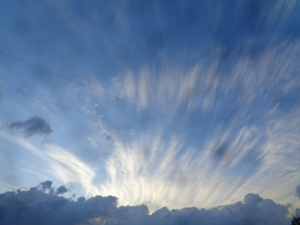
Skies Before the Fireflies Come Out Lisa A. Wisniewski
We saw our first fireflies, also known as lightning bugs, of the season earlier this week as we hurried to water the garden before dark. The sight made me recall an article I had read earlier this year about the decreasing population of these soft bodied beetles. The firefly is Pennsylvania’s state insect and was once very prevalent in our area. It is believed that loss of habitat, chemicals, and increased use of artificial light are taking a toll on the population of these insects.
Fireflies have luminescent tails that produce “cold light” with no infrared or ultraviolet frequencies. The males signal to the females in the dark with their flashing. The females respond with patterned flashes. The sequence of events leads to mating. The female is wingless, unlike the male, yet very mobile.

Be the Light Lisa A. Wisniewski
Like the fireflies, we sometimes need the dark in order to see the light or find our way in life. We also have a way of reflecting or emanating light to and among others. Often, our environments play a part in the type of light we shine.
“Every moment of light and dark is a miracle.” -Walt Whitman
Wonders of Life

Be Not Afraid Lisa A. Wisniewski
Church services are still very limited in our area due to the recovery from the pandemic. However, many churches have online resources to help the congregation keep a sense of spiritual community. One church in my area started publishing the weekly mass readings and songs in their bulletin. The addition of the songs has been a great benefit to me, for not only are the words published, but also the notes like sheet music. I appreciate this as I try to learn to play guitar better and have better luck reading music than trying to play the notes or chords by ear.
One of this week’s songs provided a great reminder and answer to a major wonder I have had—how do we move on after all that has happened in the world around us? This question has been dogging me for some time, though I keep telling myself to have faith and just do my best to live life to the fullest in a simple way. The song’s words are simple, yet profound, offering a great reason and way to move on.
Be Not Afraid

Far in Safety Lisa A. Wisniewski
You shall cross the barren desert, but you shall not die of thirst.
You shall wander far in safety though you do not know the way.
You shall speak your words in foreign lands and all will understand.
You shall see the face of god and live.
Be not afraid. I go before you always. Come follow me and I will give you rest.
If you pass through raging waters in the sea you will not drown.
If you walk amid the burning flames you shall not be harmed.
If you stand before the power of hell and death is at your side, know that I am with you through it all.

Before You Always Lisa A. Wisniewski
Be not afraid. I go before you always. Come follow me and I will give you rest.
Blessed are your poor, for the kingdom shall be theirs.
Blessed are you that weep and mourn, for one day you shall laugh.
And if wicked tongues insult and hate you all because of me, blessed, blessed are you.
Be not afraid. I go before you always. Come follow me and I will give you rest.
May the questions we have lead us to answers and peace in time. May knowledge found be shared with others along the way to make for better understanding around and within, and may we not lose the childlike curiosity of summer’s wonders.

Hot Summer Sun Lisa A. Wisniewski
Summer’s Wonders
Hot summer sun rising in the east
High above the wooded trees
And the mist of the valley below
Where a list of vetches grow
In splotches of color like a quilt
Dotting the landscape at will
Calling the child to come under
The spell falling in summer’s wonder.

Wispy Clouds at Midday Lisa A. Wisniewski
Wispy clouds at midday
Swirled about to create
Patterns far and wide
Before the night stars grace the skies
In the blue expanse of heaven above
Where the truth stands among
The angels and saints that hover under
The magic of the day in summer’s wonder.

Sunset in the West Lisa A. Wisniewski
Sunset in the west crimson and bright
Allowing the soul to find rest in its life
Amidst the colorful sea
That invites it in to just be
Part of the silence at day’s end
Before another day starts all over again
In the river running under
Time delivered by summer’s wonder.
-Lisa A. Wisniewski

Milk Vetch Lisa A. Wisniewski
Note of Thanks
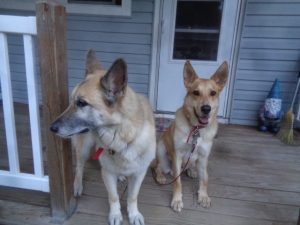
Thank You One and All Lisa A. Wisniewski
Our thanks this week goes out to our readers and followers. We know summer can be a very busy time of year when not everything on the daily to-do list gets done, and so we appreciate you taking time to view and read our posts.
-Lisa, Sadie, and Leo











